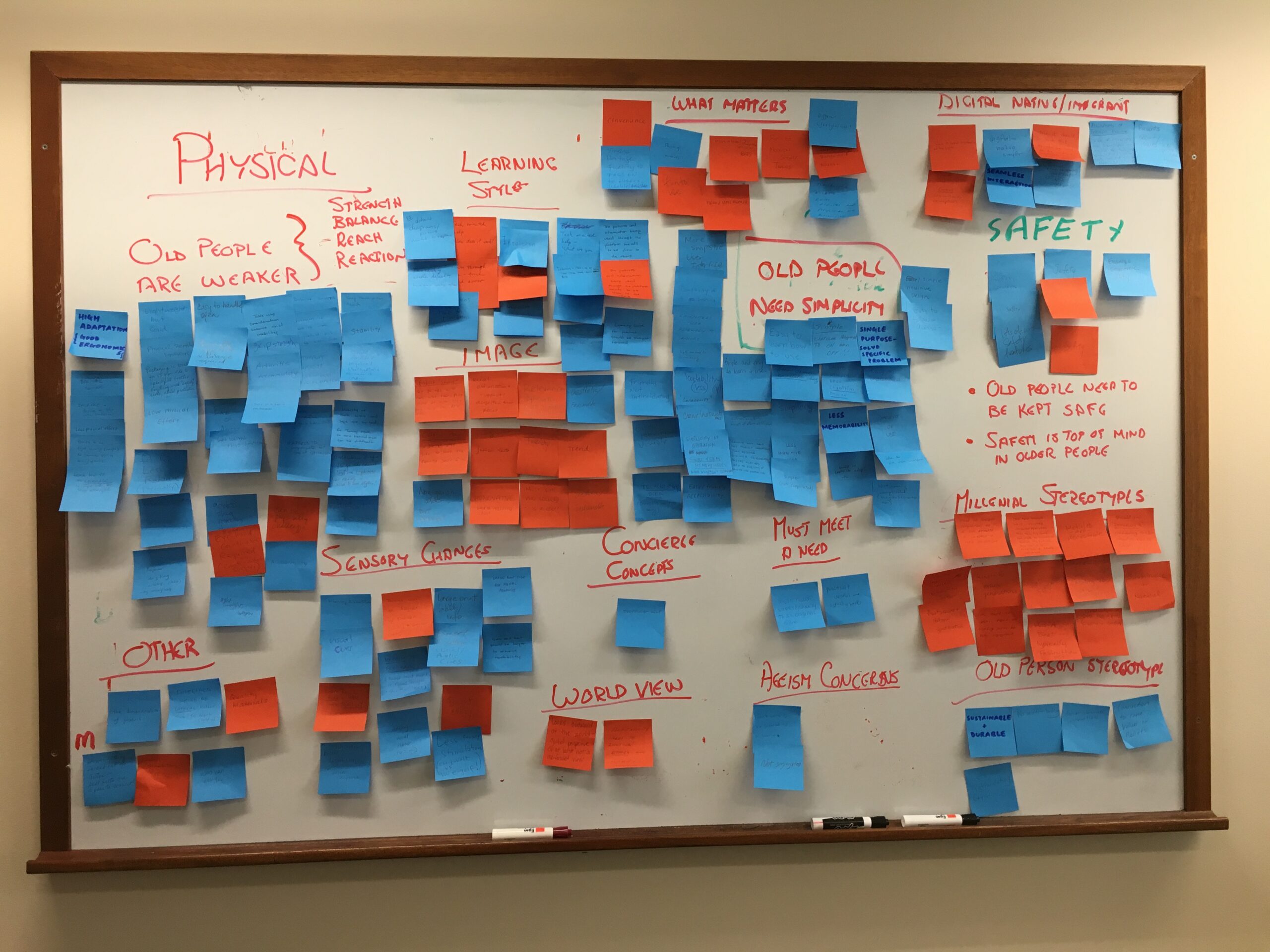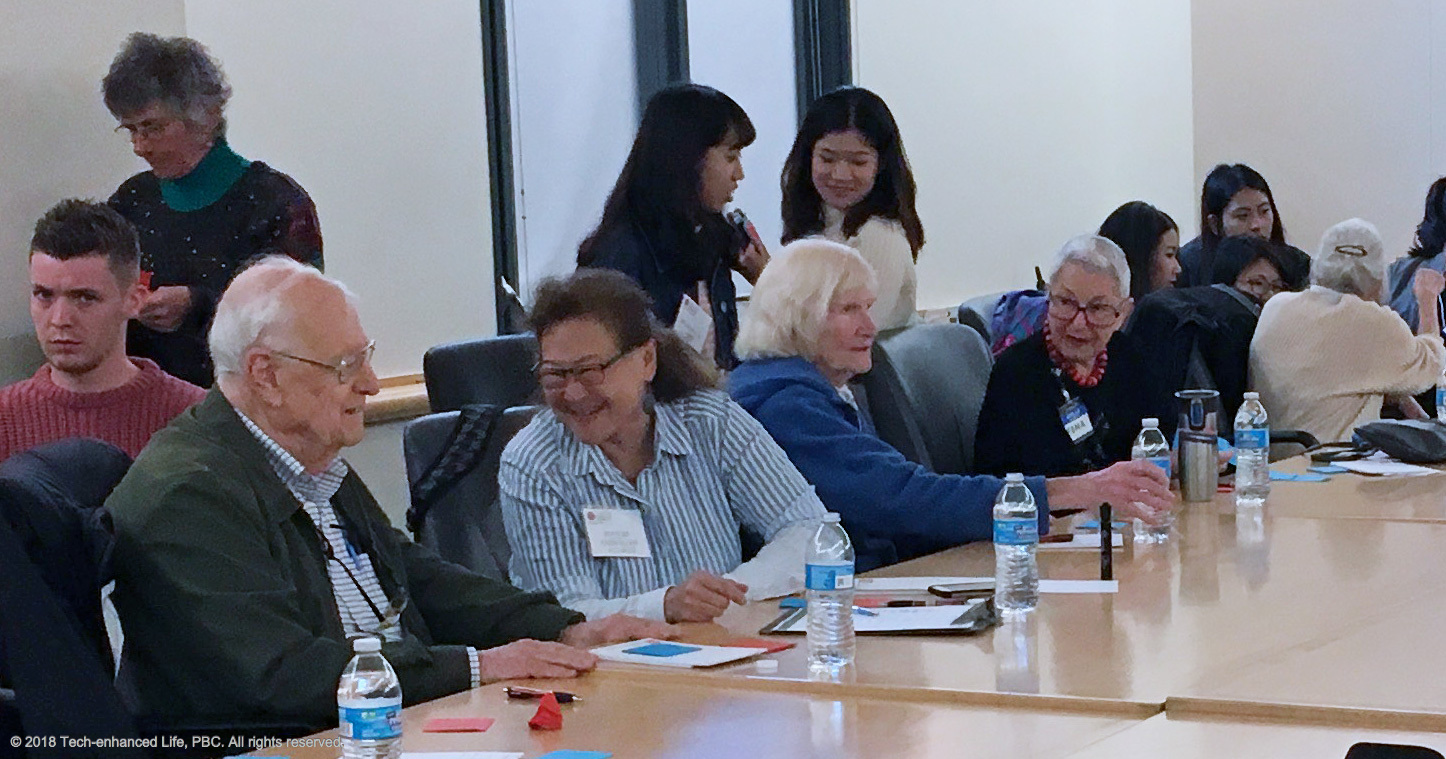By: Richard Caro | Posted: July 10, 2018 | Updated: April 5, 2023
What happens when you bring together a group of older adult Longevity Explorers and the teams participating in the Stanford Longevity Design Challenge?
You get some interesting and contrasting opinions about what the differences should be between designing for a 25 yr. old and designing for an 85 yr. old.
Table of Contents
- Intergenerational Workshop: What We Did
- The Discussions
- Post-workshop Clustering
- What We Learned
Intergenerational Workshop: What We Did
Each year the Stanford Center on Longevity holds a “Design Challenge” that involves teams from all around the world competing to design a product concept suitable for that year’s challenge topic. The topics always relate to aging or Longevity. The Challenge culminates in an event at Stanford at which the most promising teams come to Stanford, participate in various activities relating to the challenge, and a winner is announced.
This year, in April 2018, as part of the event at Stanford, the Center on Longevity collaborated with Tech-enhanced Life to organize an intergenerational workshop, including both the finalists of the design challenge (student teams) and a group of older adults from the Longevity Explorer community.
The Longevity Explorers are older adults (in their 70’s, 80’s and 90’s) who are interested in the future of aging and the intersection of aging and technology, and who ideate; evaluate new product concepts; and test out promising products — both for their own benefit, and to share the results with older adults around the world. For this workshop we selected explorers from several of our Bay Area circles, including a number from the nearby Longevity Explorers | Avenidas Village circle, a group that Dr. Caro and Tech-enhanced Life are leading, with support from Avenidas Village and the Avenidas Generations Lab.
The Theme
The authors (Ken Smith and Richard Caro), designed this Intergenerational Workshop to explore the points of view of two diverse groups, selected from very different age groups, on this topic:
“What needs to be different about design of a product to be used by 85 yr. olds compared to design of a product to be used by 25 yr. olds?”
The underlying motive for running this workshop was to promote some interaction between the two groups represented here. We felt the topic and the outputs were interesting, but almost secondary to helping the students and older adults develop some interesting interactions with each other.
Introduction to the workshop
The Workshop and the Aftermath
The workshop itself consisted of several sections, summarized below, and then we did a little post-workshop analysis of the results.
Ideation: We started the workshop with an ideation session to collect inputs from all the participants about the “theme” above. We asked people to write their opinions on post-its as to what needs to be different about design of a product to be used by 85 yr. olds compared to design of a product to be used by 25 yr. olds? And we asked people to use Blue Post-its for things that needed to be considered if designing for an 85 yr. old. Or Red Post-its for things that need to be considered for a 25 yr. old.
So, we ended up with lots of “opinions”, in the form of multiple red and blue Post-its. And these opinions came from both the students and from the older adults.
Deeper dive: In the second portion of the workshop, we selected some groupings of opinions for a group discussion to tease out the underlying views and differences between different participants. We audio recorded that, and you can read a summary below, or listen to the discussions themselves (on right if you are on a big screen; below if on mobile device).
Product concept brainstorming: Then we engaged in some collective brainstorming about a specific product concept. That portion is not included in this article but we will likely summarize it elsewhere in case people are interested.
Informal interaction: After the official portion of the workshop, everyone had lunch together. Without our prompting, the participants ended up sitting in small breakout groups — typically one or two older adults with one or two students. It was very gratifying to watch the intense and enthusiastic interactions going on, unplanned, within these breakout groups.
Clustering: Finally, after the workshop Ken and Richard spent some time clustering the various Post-it opinions into subject matter groups. You can see the results in the image further down in this article. And we discuss some of our learnings and make some editorial comments in the last few sections of this article.
Feedback: We got a lot of very positive feedback afterwards from both the Longevity Explorers and the student teams. The two demographics who came together in this workshop, unfortunately do not spend a lot of time interacting. It has been our experience that when they do, both groups get a lot out of hearing each other’s points of view. This interaction was no exception.
The Discussions
After collecting a lot of ideas and opinions from the participants (both generations being prolific contributors), we quickly grouped them into some “topic areas” and selected some interesting themes for a group discussion. NOTE: You can listen to the discussions themselves (and read more detailed summaries). See sidebar (big screen) or bottom (small screen).
Stylishness: What Is It? Do we Care About It?
There was a cluster of Post-it opinions suggesting things like stylishness, trendiness, contemporary-ness, and being fashionable mattered in designing for 25 yr. olds. There were no Post-its suggesting these things mattered for 85 yr. olds, although there was a single Post-it suggesting that color was important for a design for an 85 yr. old.
We explored this in discussion, and found things were much more nuanced than first appeared, and possibly quite different to what our participants initially thought.
In discussion, it turned out that in fact many 85 yr. olds cared a great deal about being “stylish”. But when we dug a little deeper, it became clear that the definition of stylishness varied quite a bit among participants. There was some interesting discussion of:
- the difference between “stylish” and “fashionable”;
- what “stylish” means to various older adults;
- classic vs trendy;
- do older adults care about being stylish and why?
Generational Learning Styles: Impact on Product Design
Another intriguing discussion at the workshop started with a Post-it opinion suggesting “short attention span” was a characteristic one needed to take into account in designing for 25 yr. olds, with the implication this might not matter so much in designing for 85 yr. olds.
The discussion yielded some surprises here too, and we covered things like:
- “Impatience is just not there anymore”;
- “I’m running out of time. Give it to me NOW”.
Rapidly, this discussion segued into a conversation about Learning Styles, which seemed to us to be quite important. It emerged that for these participants, there was a strong view that Learning Styles differed a great deal between the two generations represented here. And that this has profound implications in how you should think about product design — because people will learn how to use a product in very different ways depending on their generation.
Some things we covered included:
- Who reads directions?
- Trial and error vs “it just works”;
- “hours learning levels of a game. I just would never do that”;
- tradeoffs: complexity gradually and “when you need it”;
- growing up with iPads makes a difference;
- “simplicity is key”, but not “dumbed down”;
- short term memory and learning capacity not the same at 90;
- NOT “lots and lots” of instructions.
And here is an interesting quote:
“the key skills vary between the generations. For us (older adults) what mattered was finding information. For the younger generation, what matters is “cr—p detection”.
The discussion finished with an interesting thought that closed the loop on the initial “short attention span” comment. Could it be that young people have short attention spans (due to media, iPhones etc), but older adults also have short attention spans due to memory issues?
Not so different after all perhaps?
What Matters to Us: Generational Differences
The Post-its in this cluster talked about price and value and quality. Much of this seemed uncontroversial as we discussed it but a few interesting points emerged relating to:
- what people value might be rather different between generations: for example style vs safety; or trendiness vs “quality”; reliability; trust; instant gratification;
- the extreme importance of affordability for a large segment of the over 65 yr. old demographic — “for some, a $300 gadget is unthinkable“;
Connecting, Companionship, Avoiding Loneliness
The Post-its framed this as an issue primarily in designing for older adults. Ken Smith made the point that actually the age group most affected by these challenges are those around 25!
The discussion covered themes like:
- social media and the perpetual quest for interaction;
- how mobility limitation contributes to isolation;
- older adults tend to be geographically segregated, so interactions between generations are less common than they might otherwise be;
- while older adults live longer, the opportunities for grandparent – grandchild interaction are declining.
Post-workshop Clustering
Here is the final collection of Post-its, clustered by Ken and Richard after the event. Red Post-its represent things that participants think designs for 25 yr. olds need to consider. Blue Post-its represent things that participants think designs for 85 yr. olds need to consider.

Cluster Groupings
Here are the main cluster groupings we came up with. Note, we don’t necessarily agree with all these opinions of the group. But they are interesting to consider.
- Learning styles differ between the generations;
- What matters to people changes as one grows older;
- Design for “digital natives” is different to design for older generations;
- Older adults want “simplicity”(which isn’t the same as “dumbed down functionality”);
- Older adults have physical challenges that need to be taken into account;
- Older adults undergo changes to senses (vision, hearing) that are extremely important to design;
- Keeping older adults safe is important (the authors question the primacy of this, although it always comes up);
- Millenial stereotypes;
- Older adult stereotypes;
- The importance of “image”.
Editorial Comments
We only had time to discuss three opinion groupings. But in each of these discussions we found that the initial perceptions needed some revision once people had a chance to chime in and interact. We are guessing that would have been true for other cluster groupings as well.
So, our interpretation of all this is as follows.
- The Post-it maps represent “what people think before they engage in the deep discussions about intergenerational design.”
- These opinions are likely to change when older adults and younger adults get to discuss the issues and share ideas.
- For the clusters we actually discussed (above), some interesting nuances and subtleties emerged.
What We Learned
Think of this as a jumping off point for further exploration of designing products for older adults. We learned (relearned) these things.
- There are always interesting surprises and unexpected points of view when people from different backgrounds engage in this sort of group interaction.
- These sorts of intergenerational interaction are easy to arrange, and everyone enjoys them. Makes you wonder why they don’t happen more often.
- There are some interesting specific insights that emerged about the importance of stylishness for older adults; the nuances of learning style differences between generations; differences in world view and “what matters” to different generations; and various points relating to loneliness and social isolation.
*Disclosure: The research and opinions in this article are those of the author, and may or may not reflect the official views of Tech-enhanced Life.
If you use the links on this website when you buy products we write about, we may earn commissions from qualifying purchases as an Amazon Associate or other affiliate program participant. This does not affect the price you pay. We use the (modest) income to help fund our research.
In some cases, when we evaluate products and services, we ask the vendor to loan us the products we review (so we don’t need to buy them). Beyond the above, Tech-enhanced Life has no financial interest in any products or services discussed here, and this article is not sponsored by the vendor or any third party. See How we Fund our Work.




Hello,
Hello,
I am currently writing my Bachelor's Thesis on the topic of (interaction) design for older people. I think this workshop (and the Longevity Explorers in total) is an excellent example for designing with instead of for older people.
However, for me to refer to your results I am wondering whether you have published your results in the form of an academic paper?
Thank you for any help and keep up with this great work,
Lisa
Hi Lisa-Maria: Glad you like
Hi Lisa-Maria: Glad you like it. You are very welcome to reference this page of course, or other parts of this website. We would welcome that. We have not published our results in the academic literature. We are always open to collaborations with academics who want to do that.